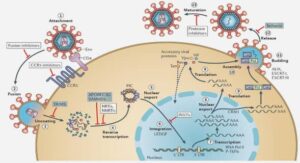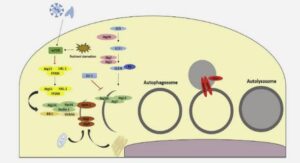Cours a novel, robust and specific biomarker that maps to parkinson’s disease stages, tutoriel & guide de travaux pratiques en pdf.
Materials and methods
Ethics statement and participant recruitment
Institutional review boards approved this study (CHU de Québec, #A13-2-1096; CHUM, #14.228; Cambridge Central Regional Ethics Committee, REC #03/303 & #08/H0306/26; and Cambridge University Hospitals Foundation Trust Research and Development department, R&D #A085170 & #A091246) in accordance with the Declaration of Helsinki, and written informed consents were obtained from all participants.
Blood samples were collected from 2 cohorts of patients with PD [one in Cambridge UK; one in Quebec Canada] as well as an independent cohort of Huntington’s disease (HD) individuals [collected in Montreal, Canada] along with age- and sex-matched healthy Controls (Table 2.1). In the case of PD patients, the UK PDS Brain diagnostic criteria were used which gives a diagnostic accuracy of 98.6% when applied by movement disorder specialists (Massano and Bhatia, 2012; Hughes et al., 2002). Their clinical evaluation included the Unified Parkinson Disease Rating Scale (UPDRS), Hoehn and Yahr (H&Y) staging, the Mini Mental State Examination (MMSE), the Addenbrooke’s Cognitive Examination (ACE) and the Beck Depression Inventory (BDI). In the case of the HD patients, their Unified Huntington Disease Rating Scale (UHDRS), Total Functional capacity (TFC) and calculated values for burden of disease (BDS) were all collected and diagnosis was confirmed by genetic testing. All clinical evaluations were conducted within 6 months of the blood collection. Participants were further asked to fill out a questionnaire related to health issues and medication and a full blood count was performed in all patients on the day of blood sampling. Medications were converted into levodopa equivalent daily dose (LEDD) using common calculator tools. It should be noted that blood sampling was conducted by the exact same team of investigators, following identical procedures in both UK and Canada.
Preparation of platelet-free plasma and EV labeling
Citrated blood was centrifuged twice for 15 minutes at 2500g at room temperature. Platelet-free plasma (PFP) was harvested and stored at -80°C within 2 hours of sampling following previously published guidelines (Lacroix et al., 2012). For specific details on EV labeling, please refer to supplementary material.
In all cases, the control samples came from healthy participants and the blood was collected at exactly the same time as the PD and HD patients in the UK and Canadian clinics. Every blood sample was processed immediately to avoid release of non-physiological EV. For analyses relating to EV in the plasma, all blood samples were centrifuged twice at 2500g to enable PFP recovery. The plasma was fractionated into 3 aliquots per individual and frozen immediately following processing (maximum of 2 hours following blood collection). Blood samples from Controls and PD were collected in parallel and laboratory analyses were blinded to participant status.
Flow cytometry quantification
For EV quantification, we used a FACS Canto II Special Order Research Product equipped with a forward scatter (FSC) coupled to a photomultiplier tube (FSC-PMT) and a small particle option. Flow cytometer performance tracking was carried out daily using the BD cytometer setup and tracking beads (BD Biosciences, San Jose, CA, USA). The size of the EV was determined using fluorescent silica beads of 100, 500 and 1000nm (figure S2.1). The settings for the EV detection were determined as previously described using a threshold of 200 for SSC (also see figure S2.1) (Rousseau et al., 2015). For specific details plasma-related EV quantification, please refer to supplementary material.
Production and purification of EEV
Blood was collected in heparin tubes and centrifuged for 10 minutes at 282g at room temperature. Blood cells were washed first in PBS-2%FBS, then with 0.9% sodium chloride solution and centrifuged for 10 minutes at 750g. To avoid leukocyte and/or platelet contamination, the buffy coat and upper fraction of erythrocytes were removed. To preserve erythrocytes, two volumes of glycerolyte 57 solution (57% glycerol, 142mM sodium lactate, 1mM KCl, 25mM sodium phosphate pH 6.8) were added to the pellet and stored at -80°C. For the production of EEV, red bloods cells were thawed and EV production was induced as previously described (Minetti et al., 2004). For specific details on EEV purification, please refer to supplementary material.
C-reactive protein, free hemoglobin and -synuclein quantification
The concentrations of C-reactive protein (CRP) and free hemoglobin were determined in the PFP of all donors using the RayBio Human CRP ELISA Kit (RayBiotech, Norcross, GA, USA) and the Hemoglobin Human ELISA kit (Abcam, Toronto, ON, Canada). To quantify -synuclein (-Syn) in erythrocytes and EEV, we used the human -Syn ELISA kit (ThermoFisher Scientific, Waltham, MA, USA). Absorbance values were measured at 450nm using a multi-detection microplate reader (Synergy HT; BioTek; Winooski, VT, USA). All ELISA tests were performed according to the manufacturer’s instructions.
Scanning electron microscopy
For the visualization by scanning electron microscopy, EEV were prepared as previously described (Duchez et al., 2015). For specific details on EEV preparation, please refer to supplementary material.
Transmission electron microscopy
For the transmission electron microscopy, EEV were prepared and observed as previously described (Duchez et al., 2015). For specific details on EEV preparation and labelling, please refer to supplementary material.
Mass spectrometry analysis and label free protein quantification
The initial proteomic analyses were performed on 3 pools of 3 blood samples of each group. Following this, we undertook a completely new set of analyses to develop a method allowing us to isolate hemoglobin and better investigate the EEV proteome. For this, EVs from an additional 4 individuals per group (Control, mild PD and moderate PD) were prepared as described above. For each individual, 25μg of protein sample, according to Bradford protein assay, were migrated onto an electrophoresis gel 4-12% Bis-Tris to separate hemoglobin from higher proteins. Following gel staining using Sypro Ruby (Thermo Fischer Scientific), the 12kDa band corresponding to the hemoglobin size was cut out and the remaining part of the gel further fractioned into 7 slices, exposed to trypsin digestion and peptide extraction on a MassPrep liquid handling robot (Waters, Milford, USA) according to the manufacturer’s specifications and the protocol of Shevchenko et al. with the modifications suggested by Havlis et al. (Shevchenko et al., 1996; Havlis et al., 2003). For specific details on protein analysis purification, please refer to supplementary material. Spectra of peptides were searched against a human protein database (Uniprot Complete Proteome, taxonomy Homo sapiens – 83512 sequences) using the Andromeda search engine included in MaxQuant software version 1.5.5.1 (Cox and Mann, 2008). MaxQuant was also used to validate proteins and peptides at a 1% False Discovery Rate using a target/decoy database search as well as to undertake a Label Free Quantification of the identified proteins using the ‘match between runs’ option.
Statistical analyses
All statistical analyses were performed by a quakified statistician and details pertaining to these analyses for each experiments are provided in the supplementary material.
Results
This study involved two cohorts of PD patients (n=60; n=36 Cambridge; n=24 Quebec) and HD patients (n=63; Quebec) at all stages of diseases along with age- and sex-matched healthy Controls (n=37 for PD; n=55 for HD) (Table 2.1) giving a total of 215 participants. First, we evaluated the diagnostic value of EV for PD and found a notable increase in the mean number of EEV in PD patients with respect to their age- and sex-matched healthy Controls (p=0.0319; figure 2.1A). A closer look at the data distribution, however, revealed that only 5 patients were responsible for this significant difference (figure 2.1A, red inset). Further investigation using a diagnostic accuracy test, revealed that the relevant proportion of the area under the Receiver Operating Characteristic (ROC) curve was 0.508 (data not shown), implying that the number of EEV could not solely be used as a discriminant between PD patients and healthy Controls. This was also confirmed by performing a Bayesian analysis of the data demonstrating that the proposed predictor of the onset of PD would be correct in less than 1% of the cases (data not shown). We obtained similar result when we separated the patients into mild and moderate states according to their UPDRS scores (data not shown).
We next evaluated the potential of EEV to map onto different PD disease stages. Analyses revealed striking correlations between the number of vesicles derived from the red blood cells of PD patients and their total UPDRS (figure 2.1B). Statistical linear regression analysis was performed for each group and the R2 values obtained demonstrated that in both cases, at least 87% of the variation in the total number of EEV/erythrocytes was due to the variation of the UPDRS (figure 2.1B). Moreover, the results are significant with respect to the p values obtained for each fit, since they fall below the 5% confidence level. Hence, the statistical tests on EEV counts uncovered a clear cut-off point between mild and moderate patients, which could not be accounted for by medication, as there was no correlation with the patients LEDD (figure S2.2A-B). Additional analyses on the number of EEV in relation to other clinical measures including H&Y stage, BDI, MMSE and ACE found no significant correlations (data not shown).
In the HD cohort, the total number of EEV between pre-manifest and manifest HD was similar to that seen in their age- and sex-matched healthy Controls (figure 2.1C). In contrast to PD, correlation analyses failed to reveal an association between the number of EEV and HD stage using the UHDRS score (figure 2.1D). Based on this, all our subsequent analyses focused only on the PD cohort. It should also be noted that total blood counts did not indicate any differences in the number of endothelial cell-, platelet-, monocyte- and granulocyte-derived EV in the platelet-free plasma (PFP) in PD (Table S2.1) and HD patients (Table S2.2) when compared to their respective control cohorts. Additionally, at the start of the study and as a precautionary measure, full blood count (figure S2.3A-C) and C-reactive protein (figure S2.3D) quantifications were obtained for all participants which revealed no differences between groups. We did, however, observe a significant increase in EEV concentration in the PFP of individuals with diabetes and those suffering, or having suffered, from cancer (data not shown) and thus these participants were excluded from our analyses. PFP samples with elevated free hemoglobin (>45 000ng/ml), potentially due to hemolysis during blood sampling, were also excluded from further EEV-related analyses (figure S2.3E) which account for the small discrepancies between the total number of participants initially recruited and those contained in each analysis.
Having established that EEV counts map to disease state in PD, we aimed to assess whether -Syn – which is not only the main component of Lewy bodies but is highly expressed in most blood cells – was differentially expressed in normal vs. diseased conditions. For this, we opted to use scanning electron microscopy, but this did not reveal any morphological changes between resting and activated erythrocytes in either condition (figure 2.2A). We further used transmission electron microscopy to quantify the number of EEV containing -Syn and phosphorylated (serine 129) forms of the protein but again no significant differences between PD patients and age- and sex-matched healthy Controls (figure 2.2B-C) were observed. Quantified -Syn levels in EEV from PD patients and Controls using commercial ELISA kits corroborated these results (figure 2.2D).
Since our combined quantification studies (ELISA and transmission electron microscopy) suggested that -Syn levels could not be used as a blood marker of disease, we sought to obtain the specific protein signature of EEV from mild and moderate PD patients (with respect to the UPDRS scores) and their age-matched Controls. Given the significant amounts of hemoglobin within erythrocytes that could mask the true nature of the protein signature in EEV, we performed a label free quantitative proteomic analysis by nanoLC/MSMS (Wither et al., 2016) using two distinct approaches: with and without hemoglobin (figure S2.4A). By removing hemoglobin, we identified a total of 818 proteins in comparison with 356 when we did not undertake this methodological step (refer to Table S2.3 for complete list of proteins) – a modification which is clearly needed to give a much more accurate evaluation of the protein content of EEV. Additionally, a Gene Ontology enrichment analysis on the ‘Cellular Component’ ontology on the two sets of identified proteins in comparison with the whole human proteome, revealed that our samples are enriched with elements associated with ‘vesicles’ and ‘hemoglobin complex’ (figure S2.4B).
Out of the 818 proteins identified in the proteome of EEV, 8 had their expression significantly modified according to the different stages of PD (figure 2.3A-B). Hierarchical clustering, coupled to a heatmap, allowed us to group individuals according to stages of disease (Control, mild PD and moderate PD) and provided compelling evidence that the 8 proteins identified could also be grouped into three categories. Proteins of group I were highly and predominantly expressed in Controls, proteins of group II were highly and predominantly expressed in mild PD patients and proteins belonging to group III were highly and predominantly expressed in moderate PD patients (figure 2.3C). This data set was further confirmed by volcano plots (figure S2.5). Of interest, two proteins of group I are associated with the regulation system of the cell (ABHD14B, NADSYN1) and one protein significantly expressed in moderate PD patients (ATP5A1) is involved in the regulation of mitochondrial ATP production.
Discussion
We have identified a novel biomarker that maps to different states of PD, using two cohorts of patients and a total of 215 participants, based on the quantification of EV shed from erythrocytes. In particular, we have shown a remarkable correlation between the number of EEV and the clinical expression/stages of PD using the standard UPDRS measure. Finding this level of correlation with such a heterogeneous disorder highlights the robustness of the biomarker we have identified. This is also unique to PD as no such changes were seen in a second neurodegenerative disorder of the brain, HD. As these EVs contain a unique protein cargo, we surmise that the EVs and their content will help us understand the basis for the different disease stages in PD, with the possibility that the disease pathogenesis changes at a critical point in its clinical course.
It has previously been reported that EV derived from the cerebrospinal fluid contain α-Syn, its associated pathogenic species as well as the LRRK2 protein (Kunadt et al., 2015; Fraser et al., 2013). However, routinely collecting cerebrospinal fluid presents a challenge given its invasive nature while plasma is a very accessible fluid that further allows real time monitoring, and thus has been more extensively studied from a biomarker perspective. Indeed, α-Syn expression has been reported in platelets, leukocytes and red blood cells, with some studies suggesting that their levels correlate with disease duration (Behari and Shrivastava, 2013; Fuchs et al., 2008; Kim et al., 2004; Li et al., 2002b; Nakai et al., 2007). However, none of these studies have shown that blood cells, or EV derived from blood cells, represent a robust biomarker of disease (see summary figure 2.4) (Nakai et al., 2007; Wang et al., 2015; Barbour et al., 2008; Pretorius et al., 2014; Nikam et al., 2009; Sudha et al., 2003; Bartels et al., 2011; Fauvet et al., 2012; Araki et al., 2016; Helferich et al., 2015; Renella et al., 2014; Abd-Elhadi et al., 2015). Despite the fact that a number of groups have reported the presence of EV in various bodily fluids of PD patients (figure 2.4) (Kunadt et al., 2015; Fraser et al., 2013; Emmanouilidou et al., 2010; Danzer et al., 2012; Alvarez-Erviti et al., 2011; Melachroinou et al., 2013; Grey et al., 2015; Kong et al., 2014; Tsunemi et al., 2014; Shi et al., 2014; Tomlinson et al., 2015; El-Agnaf et al., 2006; Stuendl et al., 2016; Ho et al., 2014; Zappulli et al., 2016), we provide clear evidence that EEV can serve as a biomarker in PD.
Although staging of PD is often done using the H&Y clinical scale, we sought to use the UPDRS given its greater sensitivity – an approach that has recently been validated (Martínez-Martín et al., 2015). Using these scores, we found that mild PD patients – with a UPDRS score lower than 37 – have an increased number of EV (correlations = 0.886); and that the exact same pattern then repeats itself with patients who had UPDRS scores between 37 and 75 (correlations = 0.873) with a marked resetting of the biomarker between these two stages. When comparing individual patients from both correlation curves, LEDD did not seem to account for the differences, as there was no correlation between the LEDD and the number of EEV. At this stage, it is unclear why there is this split in correlation around the UPDRS score and EEV counts. Building on these cross-sectional findings, ongoing longitudinal studies in larger patient cohorts, funded by the Weston Brain Institute, will allow to further investigate this.
Another important aspect of the test we have developed is its potential to be easily adopted into the clinic. Most of the tests currently developed for biomarker use in patients are time consuming and require appreciable quantities of biological samples. Our biomarker employs a user-friendly clinical test which has the potential to be easily automated using limited volumes of blood (few microliters). Finally, while proteomic studies of EEV have been previously reported (Bosman et al., 2008, 2012), their description was limited to 270 proteins (Shi et al., 2014). We herein report on an improved method to perform this type of analyses in blood samples by removing hemoglobin; a large protein that can easily mask other ones within a protein signature. Indeed, the high dynamic range of protein concentrations in erythrocytes and their EEV, due to the abundance of hemoglobin, decreases the capacity of the mass spectrometer to detect signals corresponding to low abundance proteins. Analyzing the hemoglobin, separately from the other proteins of other molecular weights allowed us to go deeper into the EEV proteome, identifying 129% more proteins than in the initial analysis. Additionally, it is important to reiterate that our proteomic analyses were performed using very stringent parameters, which included a minimum of 2 peptides per protein and p values lesser than 0.05 with an absolute z score of 1.96, corresponding to values outside of the 95% confidence range. Finally, our volcano plots and heatmap analyses revealed high specificity of the identified proteins for each group with nodes ranging between 80 and 90%. With this, reproducibility of our proteomics data is high despite the smaller sample size (analyses performed on 3 pools of 3 samples per group and subsequently on 4 individual samples per group).
Taken together, the identification of this new EEV biomarker has the potential to 1) help in the diagnosis of PD especially at a stage of disease when disease modifying therapies could have their biggest impact, 2) lead to a useful marker that tracks disease course, 3) provide a therapeutic target or marker of disease modification in the development and testing of novel disease modifying therapies and 4) offer new insights into disease pathogenesis and how it changes through the disease stages, which in turn has important therapeutic implications.
Acknowledgements
The study was funded by The Michael J. Fox foundation and the Parkinson Society Canada to F.C. as main PI who is also a recipient of a National Researcher career award from the Fonds de Recherche du Québec en santé providing salary support and operating funds. I.S.-A. was supported by a CIHR-Huntington Society of Canada postdoctoral fellowship. R.B. and J.P. are supported by the Natural Science and Engineering Research Council of Canada. R.A.B. and S.L.M. are supported by a National Institute for Health Research award of a Biomedical Research Center to the University of Cambridge and Addenbrooke’s Hospital. A.-C.D. is supported by the Fonds de Recherche des maladies Rhumatismales de l’Université Laval and the Canadian Arthritis Network. E.B. is supported by the Canadian Institutes of Health Research. N.D. MD-MSc. also funded by CIHR and by Canadian Consortium on Neurodegeneration in Aging.
The authors would like to thank all the students and staff who helped with the blood drives in Quebec city and Montreal, Mr. Richard Janvier for his very skilful electron microscopy preparation and analyses and the Bioimaging platform of the Infectious Disease Research Centre, funded by an equipment and infrastructure grant from the Canadian Foundation for Innovation and importantly, all patients and their families for being so generous with their time in participating to this study.




